engine Oldsmobile Cutlass 1998 Owner's Manuals
[x] Cancel search | Manufacturer: OLDSMOBILE, Model Year: 1998, Model line: Cutlass, Model: Oldsmobile Cutlass 1998Pages: 348, PDF Size: 17.46 MB
Page 7 of 348
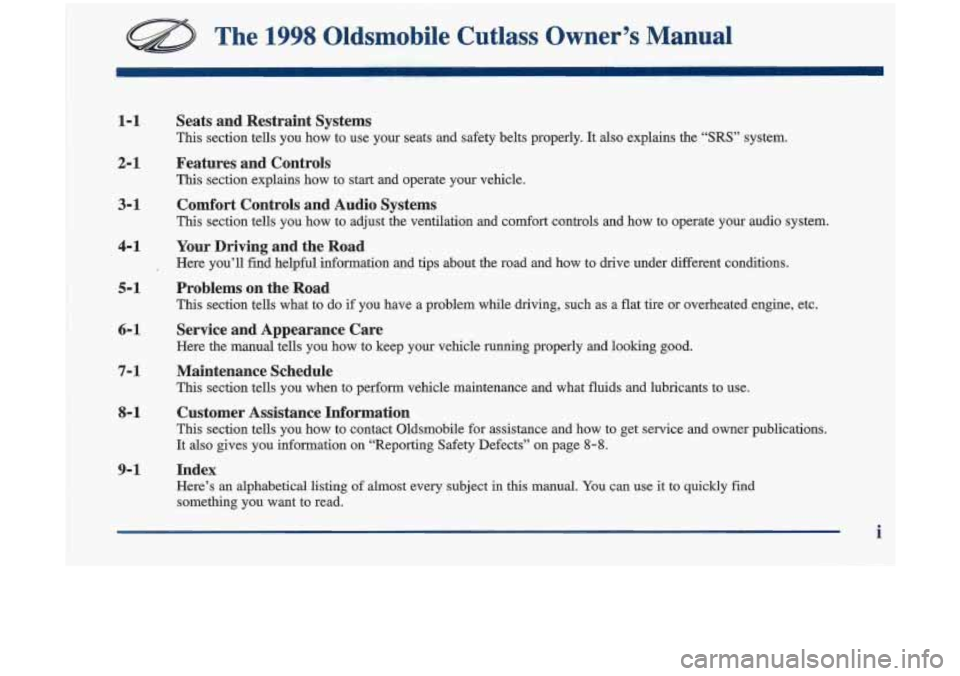
The 1998 Oldsmobile Cutlass Owner’s Manual
1-1
2-1
3- 1
4-1
5-1
6- 1
7-1
8- 1
9-1
Seats and Restraint Systems
This section tells you how to use your seats and safety belts prop\
erly. It also explains the “SRS” system.
Features and Controls
This section explains how to start and operate your vehicle.
Comfort Controls and Audio Systems
This section tells you how to adjust the ventilation and comfo\
rt controls and how to operate your audio system.
Your Driving and the Road
Here you’ll find helpful infomation and tips about the road and how to drive under different cond\
itions.
Problems on the Road
This section tells what to do if you have a problem while driving, such as a flat tire or ove\
rheated engine, etc.
Service and Appearance Care
Here the manual tells you how to keep your vehicle running pr\
operly and looking good.
Maintenance Schedule
This section tells you when to perform vehicle maintenance and \
what fluids and lubricants to use.
Customer Assistance Information
This section tells you how to contact Oldsmobile for assistance and how to get service and owner publications.
It also gives you information on “Reporting Safety Defects”\
on page
8-8.
Index
Here’s an alphabetical listing of almost every subject in this manual. You can use it to quickly find
something you want to read.
i
Page 11 of 348
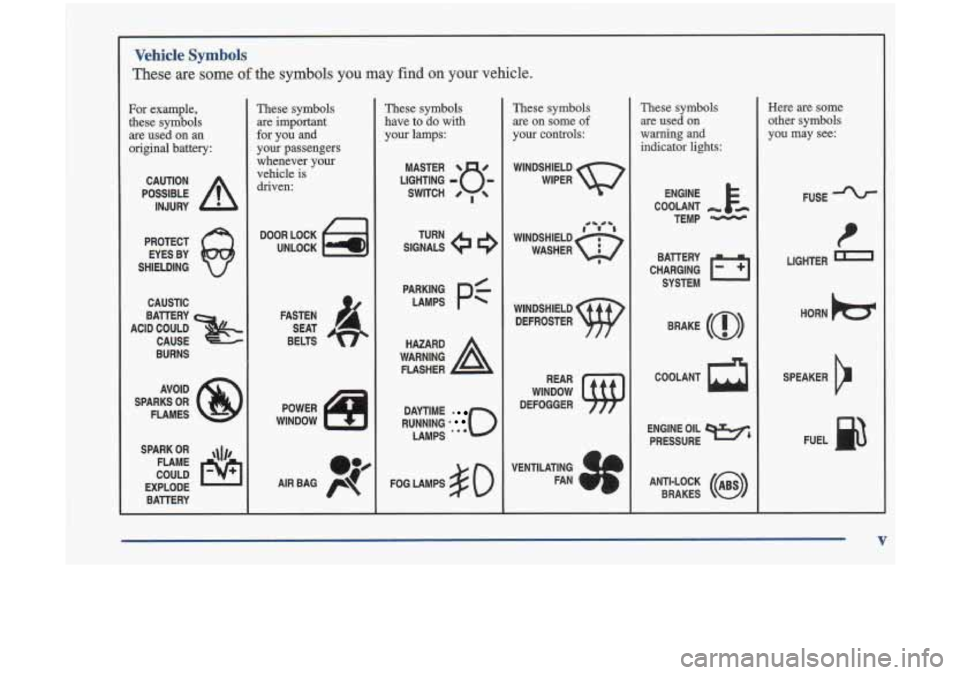
Vehicle Symbols
These are some of the symbols you may find on your vehicle.
For example,
these symbols are used on an
original battery:
POSSIBLE A
CAUTION
INJURY
PROTECT EYESBY
@
SHIELDING
CAUSTIC
ACID COULD BAllERY
CAUSE
BURNS
AVOID
SPARKS OR
FLAM€S
SPARK OR ,\I/,
COULD FLAME
EXPLODE BAllERY
These symbols
are important
for you and
your passengers
whenever your vehicle
is
driven:
UNLOCK Pa
SEAT
BELTS
POWER
WINDOW
.;/
AIR BAG p
These symbols
have to do with
your lamps:
SIGNALS e
TURN
RUNNING
* 0
DAYTIME -
LAMPS .**
FOG LAMPS $0
These symbols
are on some
of
your controls:
WINDSHIELD
wm Q
WINDSHIELD
DEFROSTER
VENTILATING
* 9
FAN 4
These symbols
are used on
warning and indicator lights:
COOLANT
TEMP
-
CHARGING I-1
BAlTERY
SYSTEM
BRAKE
(0)
ENGINE OIL e,
PRESSURE
ANTI-LOCK
(@)
BRAKES
Here are some
other symbols
you may see:
FUSE
LIGHTER
m
HORN )tr
SPEAKER
b
FUEL p3
V
Page 65 of 348
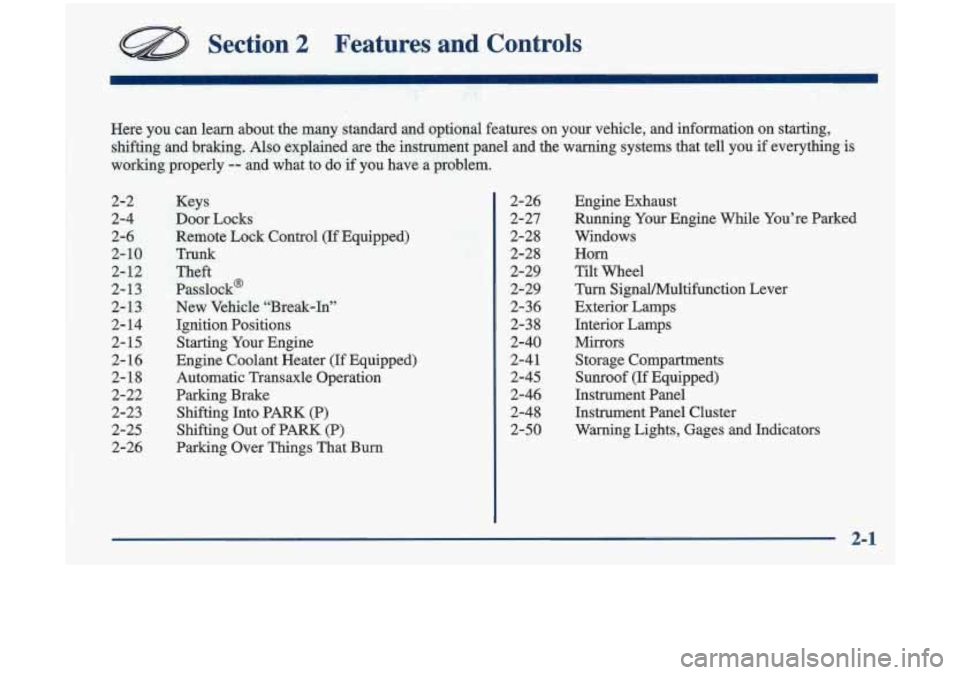
Section 2 Features and Controls
Here you can learn about the many standard and optional features on your vehicle, and inform\
ation on starting,
shifting and braking. Also explained are the instrument panel and the warning systems that tell you
if evewng is
working properly
-- and what to do if you have a problem.
2-2 2-4
2-6
2- 10
2- 12
2- 13
2-13
2- 14
2- 15
2- 16
2-18
2-22
2-23 2-25
2-26
Keys
Door Locks
Remote Lock Control
(If Equipped)
TrWnk
Theft Passlock'
New Vehicle "Break-In" Ignition Positions
Starting Your Engine
Engine Coolant Heater
(If Equipped)
Automatic Transaxle Operation
Parking Brake
Shifting
Into PARK (P)
Shifting Out of PARK (P)
Parking Over Things That Bum 2-26
2-27
2-28 2-28
2-29
2-29
2-36
2-38
2-40
2-4
1
2-45
2-46
2-48
2-50 Engine Exhaust
Running
Your Engine While You're Parked
Windows
Horn
Tilt Wheel
Turn Signal/Multifimction Lever
Exterior Lamps Interior Lamps
Mirrors Storage Compartments
Sunroof (If Equipped)
Instrument Panel Instrument Panel Cluster
Warning Lights, Gages and Indicators
2-1
Page 74 of 348
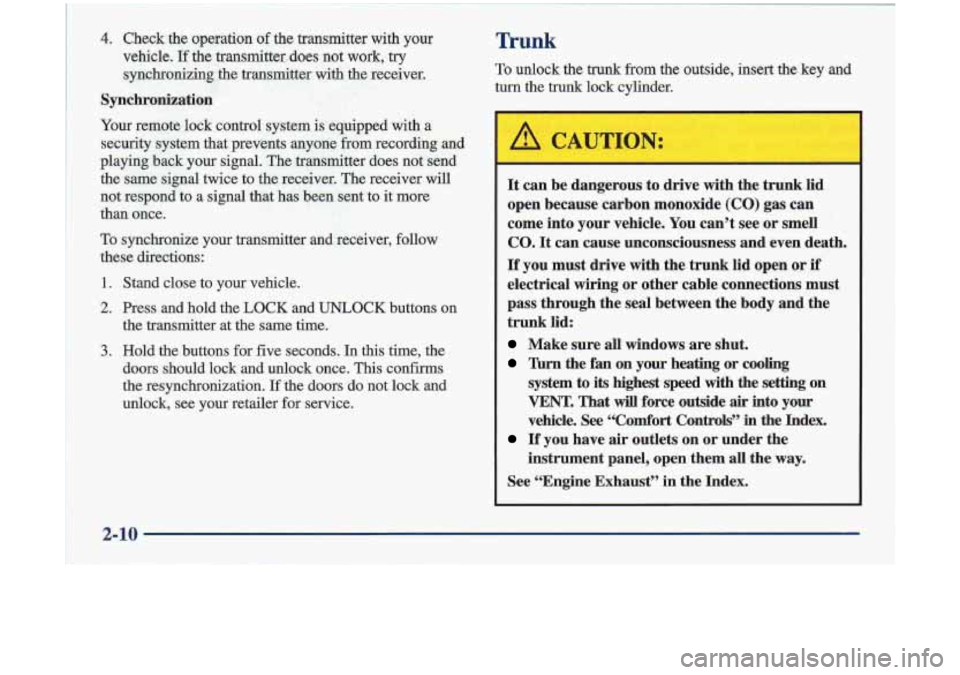
____ ~~ ~ ~~ ~ ~ ~~~
~ ~~~~
4. Check the operation of the transmitter with your
vehicle. If the transmitter does not work, try
synchronizing the transmitter with the receiver.
Synchronization
Your remote lock control system is equipped with a
security system that prevents anyone from recording and
playing back your signal. The transmitter does not send
the same signal twice to the receiver. The receiver will
not respond to a signal that has been sent to it more
than once.
To synchronize your transmitter and receiver, follow
these directions:
1. Stand close to your vehicle.
2. Press and hold the LOCK and UNLOCK buttons on
the transmitter at the same time.
3. Hold the buttons for five seconds. In this time, the
doors should lock and unlock once. This confirms
the resynchronization.
If the doors do not lock and
unlock, see your retailer for service.
~~~ .~ ~~ - ..
Trunk
To unlock the trunk from the outside, insert the key and
turn the trunZC lock cylinder.
It can be dangerous to drive with the trunk lid
open because carbon monoxide
(CO) gas can
come into your vehicle. You can’t see or smell
CO.
It can cause unconsciousness and even death.
If you must drive with the trunk lid open or if
electrical wiring or other cable connections must
pass through the seal between the body and the
trunk lid:
Make sure all windows are shut.
Thrn the fan on your heating or cooling
system to its highest speed with the setting on
VENT. That will force outside air into your
vehicle. See
“Comfort Controls’’ in the Index.
instrument panel, open them all the
way.
If you have air outlets on or under the
See “Engine Exhaust” in the Index.
2-10 B
.-
Page 77 of 348
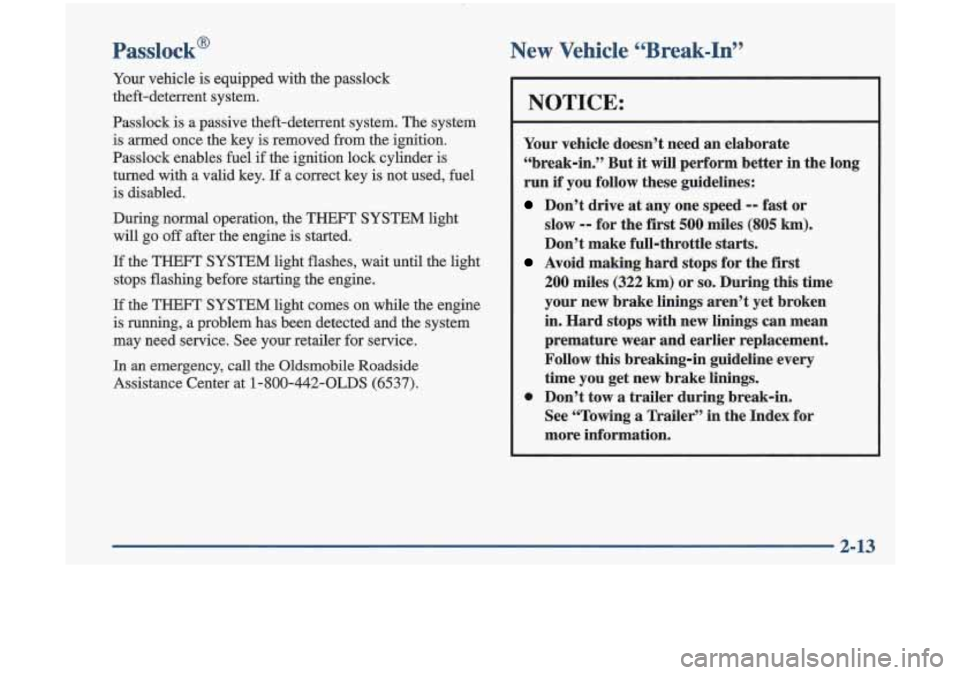
Passlock@
Your vehicle is equipped with the passlock
theft-deterrent system.
Passlock
is a~passive theft-deterrent system. The system
is armed once the key is removed from the ignition.
Passlock enables fuel if the ignition lock cylinder is
turned with a valid key.
If a correct key is not used, fuel
is disabled.
During
normal operation, the THEFT SYSm light
will go
off after the engine is started.
If the THEFT SYSTEM light flashes, wait until the light
stops flashing before starting the engine.
If the THEFT SYSTEM light comes on while the engine
is running, a problem has been detected and the system
may need service. See your retailer
for service.
In an emergency, cal
Assistance Center at 1 the Oldsmobile Roadside
1-800-442-OLDS
(6537).
New Vehicle “Break-In”
NOTICE:
Your vehicle doesn’t need an elaborate
‘70reak-in.” But
it will perform better in the long
run if you follow these guidelines:
Don’t drive at any one speed -- fast or
slow -- for the first 500 miles (805 km).
Don’t make full-throttle starts.
200 miles (322 km) or so. During this time
your new brake linings aren’t yet broken
in. Hard stops with new linings can mean
premature wear and earlier replacement.
Follow this breaking-in guideline every
time you get new brake linings.
See
“Towing a Trailer’’ in the Index for
more information.
Avoid making hard stops for the first
0 Don’t tow a trailer during break-in.
2-13
Page 78 of 348
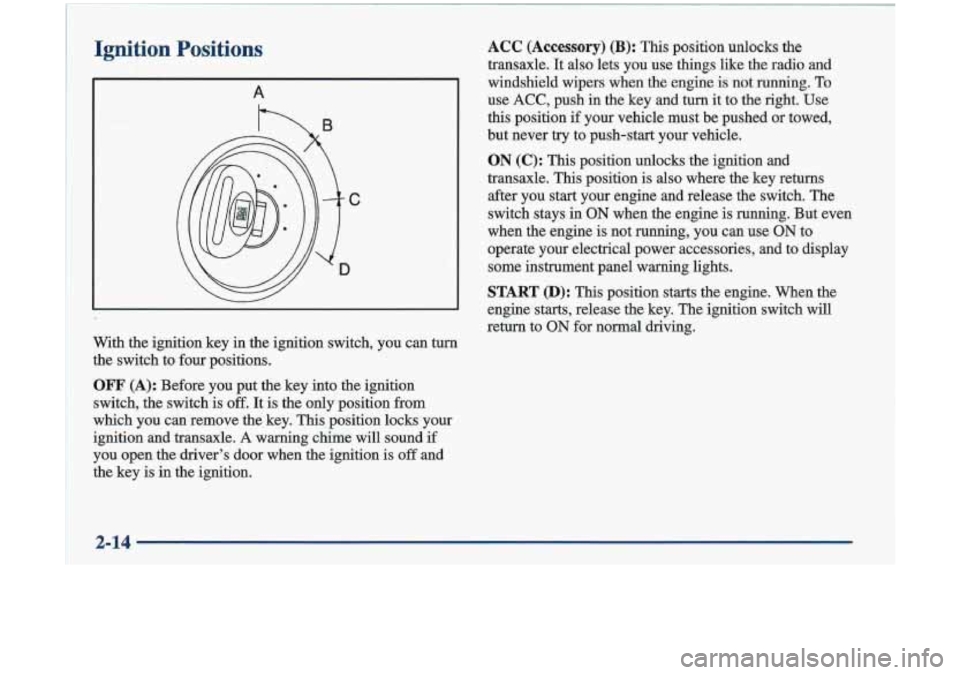
Ignition Positions
A
hB
ACC (Accessory) (B): This position unlocks the
transaxle. It also lets you use things like the radio and
windshield wipers when the engine is not running.
To
use ACC, push in the key and turn it to the right. Use
this position
if your vehicle must be pushed or towed,
but never try to push-start your vehicle.
ON (C): This position unlocks the ignition and
transaxle. This position is also where the key returns
after you
start your engine and release the switch. The
switch stays in
ON when the engine is running. But even
when the engine is not running, you can use
ON to
operate your electrical power accessories, and to display
some instrument panel warning lights.
START (D): This position starts the engine. When the
engine starts, release the key. The ignition switch will
return to
ON for normal driving.
With
the ignition key in the ignition switch, you can turn
the switch to four positions.
OFF (A): Before you put the key into the ignition
switch, the switch is
off. It is the only position from
which you can remove the key. This position locks your
ignition and transaxle.
A warning chime will sound if
you open the driver’s door when the ignition is off and
the key is in the ignition.
2-14
Page 80 of 348
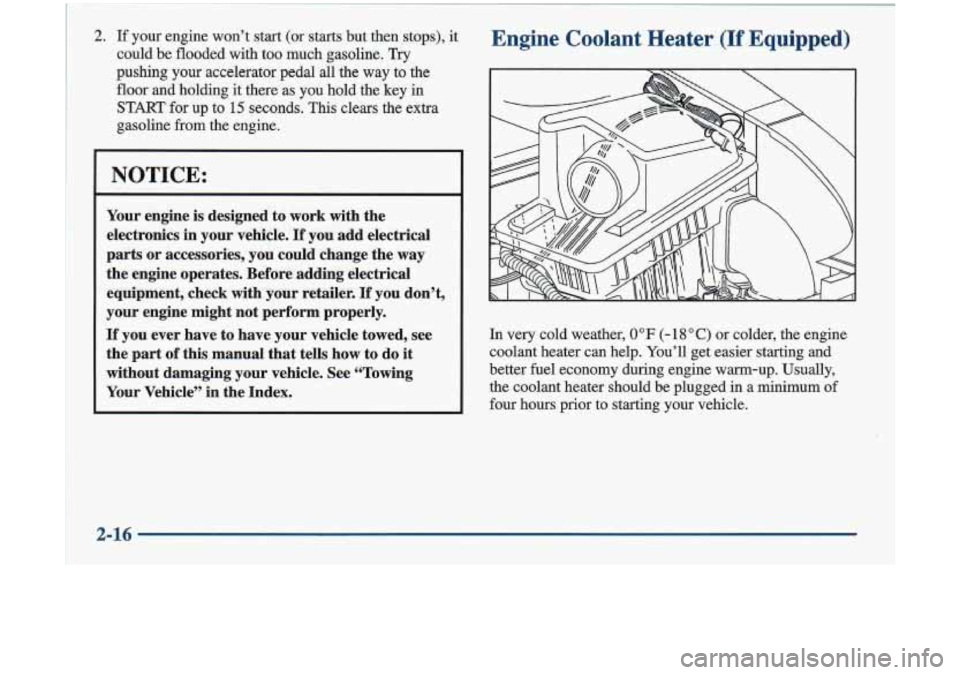
2. If your engine won’t start (or starts but then stops), it
could be flooded with too much gasoline, Try
pushing your accelerator pedal all the way
to the
floor and holding it there as you hold the key in
START for up to
15 seconds. This clears the extra
gasoline from the engine.
NOTICE:
Your engine is designed to work with the
electronics in your vehicle.
If you add electrical
parts or accessories, you could change the way
the engine operates. Before adding electrical
equipment, check with your retailer.
If you don’t,
your engine might not perform properly.
If you ever have to have your vehicle towed, see
the part
of this manual that tells how to do it
without damaging your vehicle. See “Towing
Your Vehicle” in the Index.
Engine Coolant Heater (If Equipped)
In very cold weather, 0°F (- 18 O C) or colder, the engine
coolant heater can help. You’ll get easier starting
and
better fuel economy during engine warm-up. Usually,
the coolant heater should be plugged in a minimum of
four hours prior to starting your vehicle.
2-16
Page 81 of 348
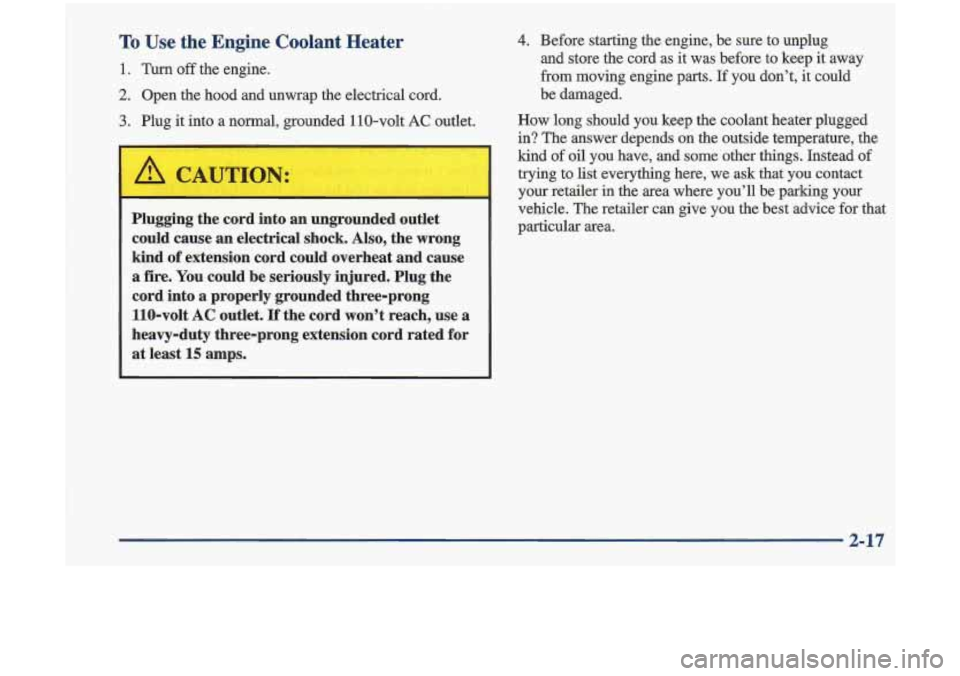
To Use the Engine Coolant Heater
1. Turn off the engine.
2. Open the hood and unwrap the electrical cord.
3. Plug it into a normal, grounded 110-volt AC outlet.
/1 CAUTION.
Plugging the cord into an ungrounded outlet
codd cause an electrical shock
Also, the wrong
kind of extension cord could overheat and cause
a fire. You could be seriously injured. Plug the
cord into a properly grounded three-prong
110-volt
AC outlet. If the cord won’t reach, use a
heavy-duty three-prong extension cord rated for
at least 15 amps.
4. Before starting the engine, be sure to unplug
and store the cord as it was before to keep it away
from moving engine parts.
E you don’t, it could
be damaged.
How long should you keep the coolant heater plugged
in? The answer depends
on the outside temperature, the
kind
of oil you have, and some other things. Instead of
trying to list everything here, we ask that you contact
your retailer
in the area where you’ll be parking your
vehicle. The retailer can give you the best advice for that
particular area.
2-17
Page 82 of 348
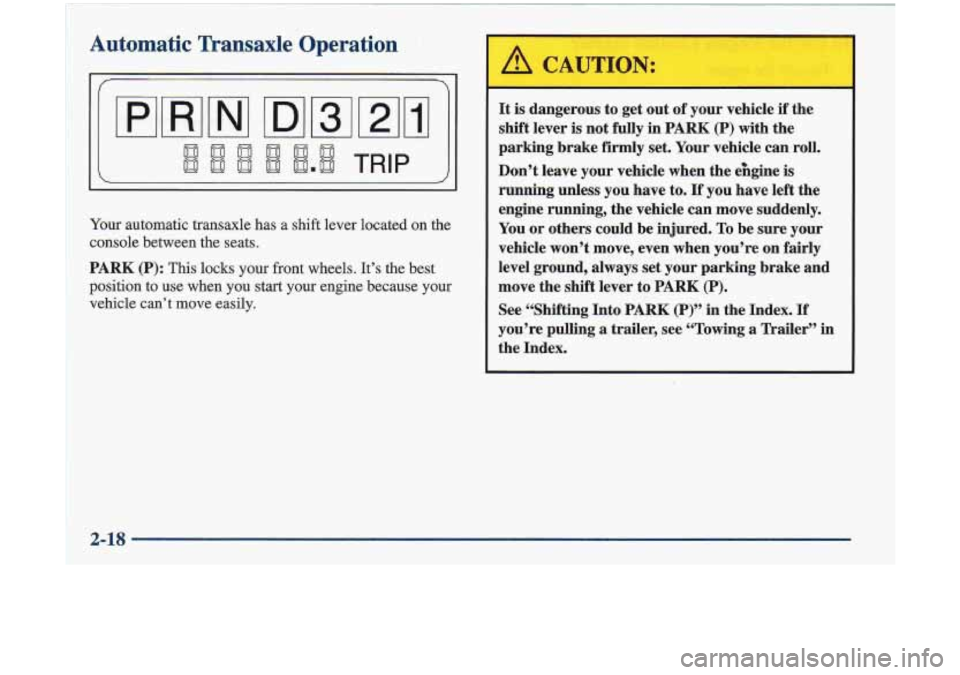
Automatic ’hansaxle Operation
k Tour automatic transaxle has a shift lever located on the
console between the seats.
PARK (P): This locks your front wheels. It’s the best
position to use when you start your engine because your
vehicle can’t move easily.
It is dangerous to get out of your vehicle if the
shift lever is not fully in PARK (P) with the
parking brake firmly set. Your vehicle can roll.
Don’t leave your vehicle when the e&&e
is
running unless you have to. If you have left the
engine running, the vehicle can move suddenly.
You or others could be injured.
To be sure your
vehicle won’t move, even when you’re
on fairly
level ground, always set your parking brake and
move the shift lever to
PARK (P).
See “Shifting Into PARK (P)” in the Index. I€
you’re pulling a trailer, see “Towing a Trailer” in
the Index.
2-18
Page 83 of 348
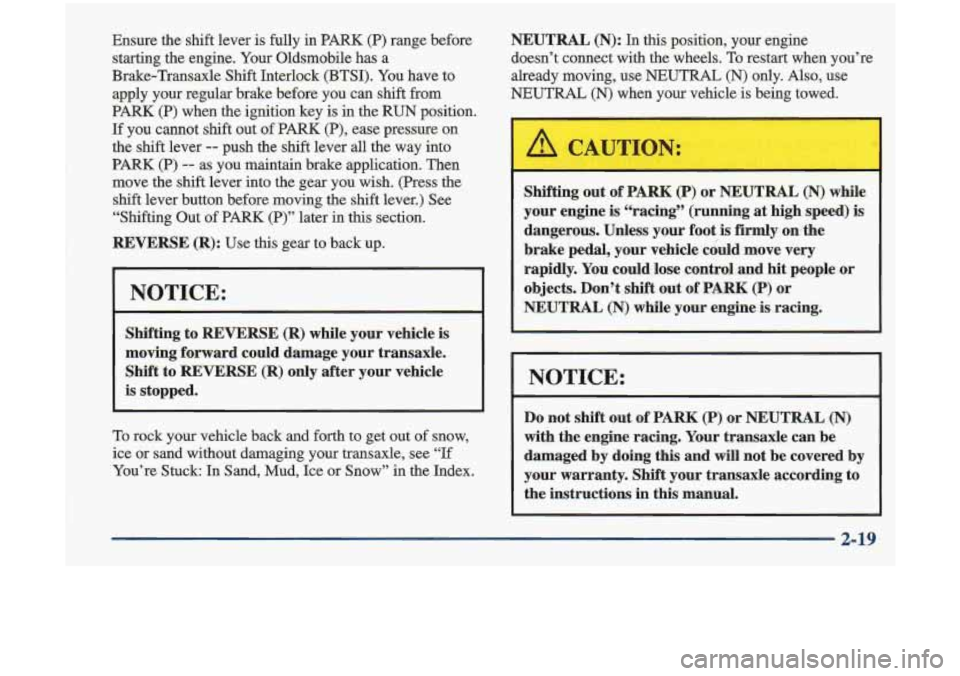
Ensure the shift lever is fully in PARK (P) range before
starting the engine. Your Oldsmobile has a
Brake-Transaxle Shift Interlock (BTSI). You have to
apply your regular brake before you can shift from
PARK
(P) when the ignition key is in the RUN position.
If you cannot shift out of PARK (P), ease pressure on
the
shift lever -- push the shift lever all the way into
PARK (P)
-- as you maintain brake application. Then
move the shift lever into the gear you wish. (Press the
shift lever button before moving the shift lever.) See
“Shifting Out of PARK
(P)” later in this section.
REVERSE (R): Use this gear to back up.
NOTICE:
Shifting to REVERSE (R) while your vehicle is
moving forward could damage your transaxle.
Shift to
REVERSE (R) only after your vehicle
is stopped.
To rock your vehicle back and forth to get out of snow,
ice or sand without damaging your transaxle,
see “If
You’re Stuck: In Sand, Mud, Ice or Snow” in the Index.
NEUTRAL (N): In this position, your engine
doesn’t connect with the wheels.
To restart when you’re
already moving, use
NEUTRAL (N) only. Also, use
NEUTRAL (N) when your vehicle is being towed.
Shifting out of PARK (P) or NEUTRAL (N) while
your engine is “racings’ (running
at high speed) is
dangerous. Unless your foot is firmly on the
brake pedal; your vehicle cdd move very
rapidly. You could lose control and hit people or
objects. Don’t shift out
of PARK (P) or
NEUTRAL
(N) while your engine is racing.
NOTICE: I
Do not shift out of PARK (P) or NEUTRAL (N)
with the engine racing. Your transaxle can be
damaged
by doing this and will not be covered by
your warranty. Shift your transaxle according to
the instructions in this manual.
2-19